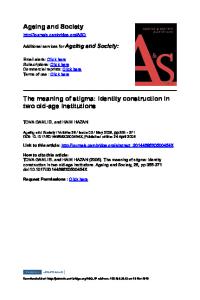Microstructural and mechanical behavior study of 5052 aluminum alloy welded by FSW process
- PDF / 894,300 Bytes
- 12 Pages / 432 x 648 pts Page_size
- 104 Downloads / 438 Views
MRS Advances © 2020 Materials Research Society DOI: 10.1557/adv.2020.20
Microstructural and mechanical behavior study of 5052 aluminum alloy welded by FSW process Jorge L. Acevedo1, Cindy E. Morales1, Bryan R. Rodriguez1, Paola B. Cerna2 1
Corporación Mexicana de Investigación en Materiales, Ciencia y Tecnología 790, Saltillo, Coahuila, México
2 Instituto Tecnológico de Saltillo, Blvd. Venustiano Carranza, Tecnológico 2400, 25280, Saltillo, Coahuila, México
Corresponding autor: [email protected]
Abstract
Nowadays the different industries is searching continuous improvements in the welding processes of the components of its products, in order to avoid the disadvantages obtained in the past by joining their parts through conventional fusion welding processes, affecting their microstructural development and consequently decreasing the principal mechanical properties. The friction-stir welding process is a solid state technique which does not reach the melting point of the material, promoting the plasticization of the metal by controlling its microstructure and mechanical behavior. However, the after mentioned advantages are the result of an adequate control of the process parameters, so that the aim of the present investigation is to study the microstructural and mechanical development of 5052-H32 butt joints welded by FSW process using a high wear resistance tool (PCBN tool) as well as the mechanical behavior suffered.
INTRODUCTION Currently the employment of different welding process at industrial level is continuously implemented for search the decrease of several disadvantages obtained with conventional welding processes obtained before. It has been observed that for specific applications the use of conventional fusion welding is detrimental to the welded joint, affecting their microstructural development and consequently their mechanical 3041
Downloaded from https://www.cambridge.org/core. Macquarie University, on 11 Apr 2020 at 16:09:06, subject to the Cambridge Core terms of use, available at https://www.cambridge.org/core/terms. https://doi.org/10.1557/adv.2020.20
performance so that, the implementation of new technologies it is considered crucial to improve the efficiency and quality of their products. One of these newly joint technologies is the friction stir welding, well known since its discover (England,1991) as a solid state joining method that works below the melting point temperature of the material. This process plasticize the metal avoiding the high heat inputs in addition to other complications when are employed the conventional fusion processes, nevertheless it is necessary to mention that an adequate control of the process parameters is necessary as in studies as Zhaohua [1] and Sagheer-Abbasi [2] [3]–[7]. One of the most important variables of the process is the welding tool, so that many studies vary this parameter specifically, Hovanski [8], Kumar [9], Meilinger and Imre Török [10]. Another improvement that these type of industries is trying to implement is the use of materials that c
Data Loading...











